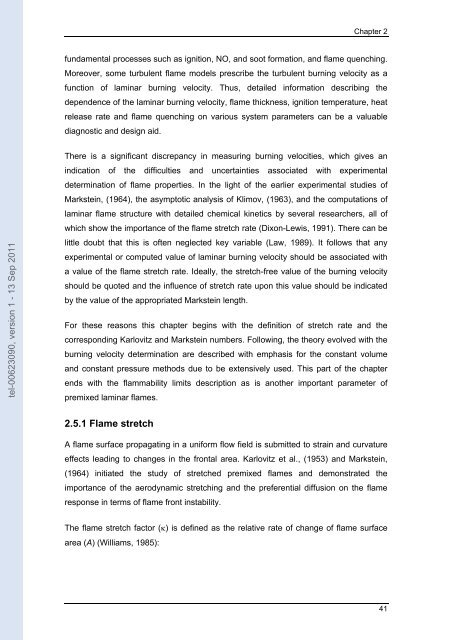Etude de la combustion de gaz de synthèse issus d'un processus de ...
Etude de la combustion de gaz de synthèse issus d'un processus de ...
Etude de la combustion de gaz de synthèse issus d'un processus de ...
You also want an ePaper? Increase the reach of your titles
YUMPU automatically turns print PDFs into web optimized ePapers that Google loves.
Chapter 2<br />
fundamental processes such as ignition, NO, and soot formation, and f<strong>la</strong>me quenching.<br />
Moreover, some turbulent f<strong>la</strong>me mo<strong>de</strong>ls prescribe the turbulent burning velocity as a<br />
function of <strong>la</strong>minar burning velocity. Thus, <strong>de</strong>tailed information <strong>de</strong>scribing the<br />
<strong>de</strong>pen<strong>de</strong>nce of the <strong>la</strong>minar burning velocity, f<strong>la</strong>me thickness, ignition temperature, heat<br />
release rate and f<strong>la</strong>me quenching on various system parameters can be a valuable<br />
diagnostic and <strong>de</strong>sign aid.<br />
tel-00623090, version 1 - 13 Sep 2011<br />
There is a significant discrepancy in measuring burning velocities, which gives an<br />
indication of the difficulties and uncertainties associated with experimental<br />
<strong>de</strong>termination of f<strong>la</strong>me properties. In the light of the earlier experimental studies of<br />
Markstein, (1964), the asymptotic analysis of Klimov, (1963), and the computations of<br />
<strong>la</strong>minar f<strong>la</strong>me structure with <strong>de</strong>tailed chemical kinetics by several researchers, all of<br />
which show the importance of the f<strong>la</strong>me stretch rate (Dixon-Lewis, 1991). There can be<br />
little doubt that this is often neglected key variable (Law, 1989). It follows that any<br />
experimental or computed value of <strong>la</strong>minar burning velocity should be associated with<br />
a value of the f<strong>la</strong>me stretch rate. I<strong>de</strong>ally, the stretch-free value of the burning velocity<br />
should be quoted and the influence of stretch rate upon this value should be indicated<br />
by the value of the appropriated Markstein length.<br />
For these reasons this chapter begins with the <strong>de</strong>finition of stretch rate and the<br />
corresponding Karlovitz and Markstein numbers. Following, the theory evolved with the<br />
burning velocity <strong>de</strong>termination are <strong>de</strong>scribed with emphasis for the constant volume<br />
and constant pressure methods due to be extensively used. This part of the chapter<br />
ends with the f<strong>la</strong>mmability limits <strong>de</strong>scription as is another important parameter of<br />
premixed <strong>la</strong>minar f<strong>la</strong>mes.<br />
2.5.1 F<strong>la</strong>me stretch<br />
A f<strong>la</strong>me surface propagating in a uniform flow field is submitted to strain and curvature<br />
effects leading to changes in the frontal area. Karlovitz et al., (1953) and Markstein,<br />
(1964) initiated the study of stretched premixed f<strong>la</strong>mes and <strong>de</strong>monstrated the<br />
importance of the aerodynamic stretching and the preferential diffusion on the f<strong>la</strong>me<br />
response in terms of f<strong>la</strong>me front instability.<br />
The f<strong>la</strong>me stretch factor (κ) is <strong>de</strong>fined as the re<strong>la</strong>tive rate of change of f<strong>la</strong>me surface<br />
area (A) (Williams, 1985):<br />
41

















